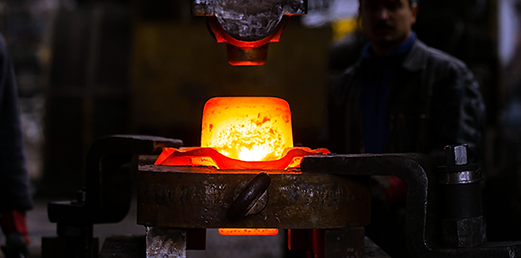Forging
Closed Die Forging is a forging process in which dies move towards each other and cover the workpiece in whole or in part. The heated raw material, approximately the shape or size of the final forged part, is placed in the bottom die. The forging body is incorporated as a negative image in the top or bottom die. Coming from above, the impact of the top die on the raw material forms it into the required forged form.

Forgings have high structural reliability when compared to a cast component. No internal gas pockets or voids could cause unexpected failure under stress or impact. Often, the forging process assists in improving the chemical segregation of the forging stock by moving centerline material to various locations throughout the forging. Forgings are typically used in automotive and trucks, off-highway and agricultural machines, etc. for connecting rods, crankshafts, transmission shafts, gears, spike harrow teeth, etc.
Capability: Closed die forging 0.5 ton and 1 ton
Main steps involved in closed die steel forging processes are die/tool making, billet cutting, billet heating, forging, trimming, heat treatment, shot blasting, machining, surface treatment, inspection, and packaging.

Step 1: Die Design & Making
The first step of the closed-die forging manner is to create a mould. A mould allows us to forge the hot metallic into a precise shape which has been detailed by means of the client. We can create quite a number of parts out of a range of distinctive metals in a range of shapes and sizes.


Step 2: Material Selection & Pre-processing
Depending on what is needed from the part, many factors come into play. Metal can be forged into different strengths or different weights. Various materials and the grades in which are work are Stainless Steel, Carbon Steel, and Alloy Steel. Before forging the steel billet, it needs to be heated to a desired temperature. After heating, it is then transported to the forging machine using tongs. There remains less than a minute to respond to the heated metal before it cools down.
Step 3: Forging
After heating billets, heated steel bars will be placed under upper and lower dies, and then pressed into the desired shape, but redundant material will be shown around the product, which is named flash.

Step 4: Trimming
As the moulds are made up of an upper die and lower die when forging, excess material will come out during the deformation process. To obtain net-shape forging blanks, such a flash needs to be removed. So forgings with flash will be placed in simple trimming dies in the punching machine, and the punching operation will remove the flash directly.




Step 5: Shot Blasting
Steel forgings will be shot blasted to get rid of the scale and get a superior surface finish. After shot blasting, products will appear considerably more smooth and more transparent.
Step 6: Machining
Although though forging blanks have tighter tolerances than casting blanks, occasionally this is still insufficient for application; in these circumstances, machining is required. The NC lathe and CNC are the primary machining tools used in our business. While CNC is used for precise, expensive machining, NC lathes are utilised for simple machining.
Step 7: Heat Treatment
Heat treatment uses heating or cooling—typically to very high temperatures—to harden or soften materials in order to obtain the desired outcome. Annealing, case hardening, precipitation strengthening, tempering, carburizing, normalising, and quenching are all heat treatment processes.
Step 8: Inspection
When determining if a product complies with requirements, numerous product qualities are measured, examined, tested, or gauged. The results are then compared to the requirements.
Precision Machining
Precision machining is a subtractive process where custom software, engineered tools, and process steps are utilized with raw materials such as plastic, ceramic, metal, or composites to create desired fine-featured products. Precision machining often follows the instructions given by computer-aided design (CAD) and computer-aided manufacturing (CAM) programs. These programs and blueprints enhance the ability to meet tight tolerances. While most designs end up as engineered and computer-aided designs, many start out as hand-drawn sketches in the initial phases.
Our machining capabilities include 5 CNC turning machines, a CNC milling machine.


